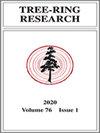PDSI Reconstruction from Tree Rings in Central Siberia (Russia)
IF 1.1
4区 农林科学
Q3 FORESTRY
引用次数: 0
Abstract
ABSTRACT This report describes an international summer course, “Tree Rings, Climate, Natural Resources, and Human Interaction”, held in Cheriomushki, Russia, in the summer of 2018. The course was attended by 12 participants from six countries (Belgium, India, Lebanon, Poland, Russia, and South Africa) and instructors from the USA and included basic training in dendrochronology skills and dendroclimatology and dendroecology projects. This report focuses on a nested May–July Palmer Drought Severity Index (PDSI) reconstruction from annual rings of Pinus sylvestris trees growing in the region and also explores false-ring (FR) occurrence in samples collected during the course. Four chronologies, one developed during the course from Maina District, Khakassia, Russia, are used in the reconstruction, which was based on principal component (PC) regression. The nested reconstruction demonstrated a strong statistical relationship between PDSI and tree-ring growth and allowed for an assessment of climate variability on both interannual and interdecadal time scales. FR occurrence in tree cores collected along an elevational transect from a site along the Yenisei River north of Cheriomushki was found to differ depending on the position of trees on the slope. The frequency of FRs and the location of the FR within the annual ring also appear to be related to seasonal precipitation anomalies.西伯利亚中部树木年轮的PDSI重建(俄罗斯)
本报告描述了2018年夏季在俄罗斯切里奥穆什基举办的“树木年轮、气候、自然资源和人类互动”国际暑期课程。来自6个国家(比利时、印度、黎巴嫩、波兰、俄罗斯和南非)的12名学员和来自美国的教员参加了该课程,课程内容包括树木年代学技能、树木气候学和树木生态学项目的基本培训。本报告侧重于从该地区生长的西尔维斯特松年轮中重建巢式5 - 7月帕尔默干旱严重指数(PDSI),并探讨了在此过程中收集的样本中发生的假年轮(FR)。重建中使用了四个年表,其中一个是在俄罗斯哈卡西亚的Maina地区开发的,这是基于主成分(PC)回归的。巢式重建表明PDSI与树木年轮生长之间有很强的统计关系,并允许在年际和年代际时间尺度上评估气候变率。在Cheriomushki以北叶尼塞河(Yenisei River)沿岸沿海拔样带收集的树芯中,FR的发生率因树木在斜坡上的位置而异。FR的频率和FR在年轮内的位置似乎也与季节降水异常有关。
本文章由计算机程序翻译,如有差异,请以英文原文为准。
求助全文
约1分钟内获得全文
求助全文
来源期刊

Tree-Ring Research
农林科学-林学
CiteScore
2.40
自引率
12.50%
发文量
15
审稿时长
>36 weeks
期刊介绍:
Tree-Ring Research (TRR) is devoted to papers dealing with the growth rings of trees and the applications of tree-ring research in a wide variety of fields, including but not limited to archaeology, geology, ecology, hydrology, climatology, forestry, and botany. Papers involving research results, new techniques of data acquisition or analysis, and regional or subject-oriented reviews or syntheses are considered for publication.
Scientific papers usually fall into two main categories. Articles should not exceed 5000 words, or approximately 20 double-spaced typewritten pages, including tables, references, and an abstract of 200 words or fewer. All manuscripts submitted as Articles are reviewed by at least two referees. Research Reports, which are usually reviewed by at least one outside referee, should not exceed 1500 words or include more than two figures. Research Reports address technical developments, describe well-documented but preliminary research results, or present findings for which the Article format is not appropriate. Book or monograph Reviews of 500 words or less are also considered. Other categories of papers are occasionally published. All papers are published only in English. Abstracts of the Articles or Reports may be printed in other languages if supplied by the author(s) with English translations.
 求助内容:
求助内容: 应助结果提醒方式:
应助结果提醒方式:


